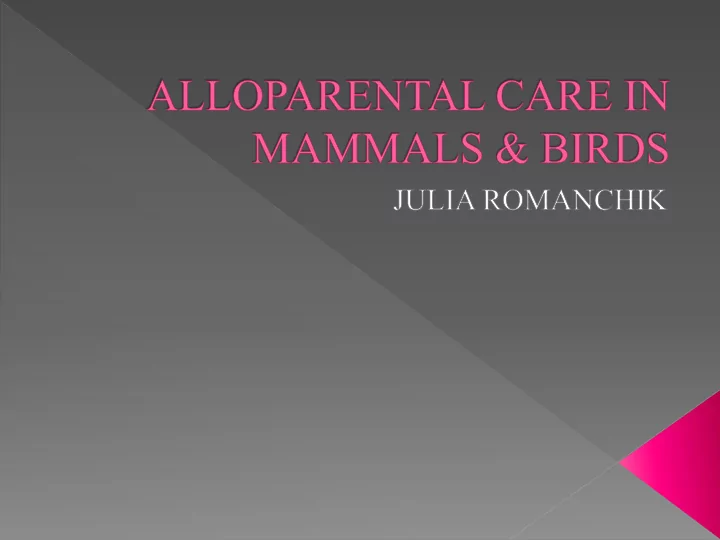

Introduction Reasons Alloparental Care Occur Benefits of Alloparental Care Conclusions
Interest in this study derives from the altruistic indications of this behavior, since helpers seem to directly improve the survival and consequently the reproductive success of the breeding individuals, at the expense of the helper . (Gilchrist, 2007) Researchers use a cost-benefit analysis strategy to determine why Alloparental Care and Cooperative Breeding occurs in Birds and Mammals. It is though that these phenomenon occur when there are benefits to the Alloparent, the Genetic Parent, the Offspring, or the entire Group.
At least 3% of bird and mammal ALLOPARENTAL CARE: species exhibit cooperative breeding Individuals other than the characteristics (Komdeur, 2006) genetic parent contribute to the care of conspecific young (Wilson in Riedman, 1982) COOPERATIVE BREEDING: Situations where more than a single parenting pair show helping behavior towards offspring ( Jennions & Macdonald, 1994) ADOPTION: Special Case http://www.fanpop.com/spots/zebras/images/24515117/title/baby-zebra-photo
K-Selectivity of Mammals & Birds › Energy-Intensive Prolonged Offspring Care REPRODUCTION Gestation & Post-Natal Cost (Riedman, 1982) › Limited Production Output Kin selection allows helpers to increase their fitness indirectly (Elman et all, 1991) Social Nature of Mammals & Birds › Tight Kingship Bonds › Social & Cooperative Structure SOCIALITY Leads to cohesive group benefits (Jennions & Macdonald, 1994) › High-Density Breeding Colonies Individuals have a reduced chance of mating success, so they opt to help until conditions become more favorable (Riedman, 1982)
Animals sometimes care for offspring, not their own, due to lack of Kin- Recognition (Pierotti, 1991) The death of offspring drive individuals to assist family members with http://nilikutashani.wordpress.com/2010/04 offspring care (Pierotti, 1991) /05/walvis-bay/
INCREASED FORAGING EFFICIENCY: Group ENVIRONMENTAL LIMITS size increases ability to catch, produce, & defend food (Clutton-Brock, 2002) A PLACE TO CALL HOME : Helpers stay to “pay rent” during limited territory conditions (Gilchrist, 2007) KINGFISHERS http://blog.simplyhike.co.uk/index.php/2011/05/kingfisher-family- caught-on-camera/
Reciprocal Cooperation of Parents › Breeders may exchange beneficial acts as a form of reciprocal altruism (Clutton-Brock, 2002) Reciprocal Cooperation of Offspring › Offspring assist alloparent in raising his/her own offspring (Gilchrist, 2007)
PARENTAL EXPERIENCE: Brown Hyena Helpers gain experience raising young (Riedman, 1982) INCREASED STATUS: Placement to succeed dominant individual (Cockburn, 1998) PROTECTION: Reduced predation risk (Jennions and Macdonald, 1994) REPRODUCTIVE http://www.africatravelresource.com/africa/ BENEFITS: Breeders trade guide/article-what-are-the-best-animal- reproductive allowances for interaction-experiences-on-safari/ help (Gilchrist, 2007)
Birds & Mammals are able to participate in Alloparental Care due to their Life History and Sociality Alloparental Care occurs when there is minimal cost to the Alloparent, a benefit to the Alloparent, or when the cost-benefit ratio evens out to neutral. However, some researchers believe mutualism may play an important role in the evolution of cooperative behavior. (Clutton-Brock, 2002)
CHIMPANZEE: A Disney Nature Film Coming to Theaters April 20th
Cockburn, A. Evolution of helping behavior in cooperatively breeding birds. 1998. Annual Reviews Ecological Systems. 29: 141-177. Clutton-Brock, T. 2002. Breeding together: kin selection and mutualism in cooperative vertebrates. Science. 298: 64-68. Emlen, S.T, Reeve, H.K., Sherman, P.W., Wrege, P.H., Ratnieks, F.L.W., Shellman-Reeve, J. 1991. Adaptive versus nonadaptive explanations of behavior: The case of alloparental helping. The American Naturalist. 138: 259-270. Gilchrist, J.S. 2007. Cooperative behavior in cooperative breeders: costs, benefits, and communal breeding. Behavioural Processes. 76: 100-105. Jennions, M.D. and Macdonald, D.W. 1994. Cooperatice breeding in mammals. Tree. 9: 89-93. Komdeur, J. Variation in individual investment strategies among social animals. 2006. Ethology. 112: 729-747. Pierotti, R. 1991. Infanticide versus adoption: An intergenerational conflict. The American Naturalist. 138: 1140-1158. Riedman, M.L. 1982. The Evolution of alloparental care and adoption in mammals and birds. The Quarterly Riview of Biology. 57: 405-435.
Recommend
More recommend